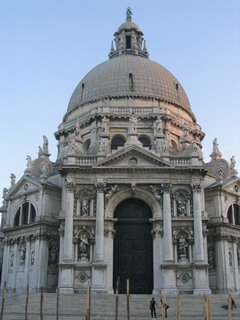
|
|
The Santa Maria della Salute
Over the centuries, diseases have contributed mightily to great art and architecture.
The church of Santa Maria della Salute is a case in point. In October of 1630, after nearly
a third of Venice's 150.000 citizens had been killed by plague, the Venetian Senate made an
offer to God : "Stop the plague, and we'll build a church to honour the Virgin Mary."
God came through, or maybe the onset of cooler weather reduced the population of plague-ridden
fleas. Whatever the reason, the plague was stopped in its tracks. The Venetian authorities
honoured their promise by giving the Virgin a prime chunk of real estate near the tip of
Dorsoduro, where the Grand Canal merged with St. Mark's Basin.
In the resulting competition for a church design, the winner was an unknown architect
named Baldassare Longhena, who had proposed a massive octagonal basilica that combined
elements of Venetian Byzantine architecture with domes inspired by St. Peter's in Rome.
Longhena described his design as "strange, worthy, and beautiful ... in the shape of a
round 'machine' such as had never been seen, or invented either in its whole or in part
from any other church in the city."
The biggest masterpiece inside is the famous "Marriage at Cana (1551), considered by many
as the greatest work of Tintoretto. On the ceiling there are splendid frescos by
Tiziano Vecellio (Titian) including "Abraham’s sacrifice", and "Cain Killing Abel".
Other works by Titian are "St.Mark Enthroned with Saints" and the Descent of the Holy Spirit.
It's beyond the scope of this article to describe the church's architectural features and
interior, suffice it to say that the church is massive and awe-inspiring, with a huge central
space surrounded by archways that lead to side chapels. The basilica and its dramatic steps
of white Istrian stone are built on 1,156,627 wooden pilings that remain intact after more
than 300 years.
Santa Maria della Salute is on the opposite side of the Grand Canal from St. Mark's Square,
near the triangular tip of the Dorsoduro quarter. If you're visiting the Accademia art gallery
or the Peggy Guggenheim Collection, Salute is easily to reach on foot from either of those
museums.
The No. 1 water bus stops at the nearby Salute vaporetto platform, which is between
the Santa Maria del Giglio and San Marco stations. Alternatively, you can ride the
traghetto from the Campo del Traghetto in San Marco, then walk to the Salute from
the landing on the Dorsoduro side.
After exploring the Salute church, be sure to visit the Dogana di Mare (the old maritime
customs house) next door. And if you don't mind a bit more walking, continue around the
tip of Dorsoduro and stroll down the Zattere for a nice view of Giudecca, another of
Venice's islands, across the wide Giudecca Canal.

|
